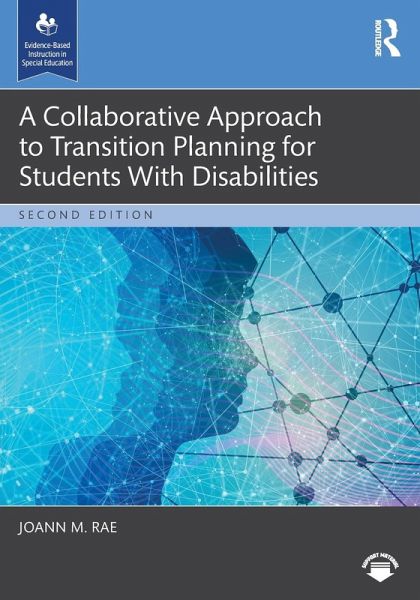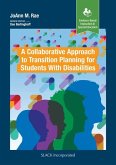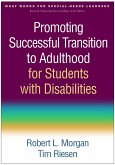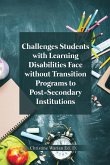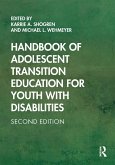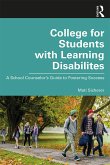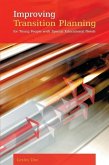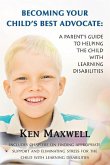JoAnn M. Rae
A Collaborative Approach to Transition Planning for Students With Disabilities
JoAnn M. Rae
A Collaborative Approach to Transition Planning for Students With Disabilities
- Broschiertes Buch
- Merkliste
- Auf die Merkliste
- Bewerten Bewerten
- Teilen
- Produkt teilen
- Produkterinnerung
- Produkterinnerung
The book's framework is specially designed to advance students' involvement and participation in their lives, not only in the presence of the most severe sensory and intellectual disabilities, but also in the case of multiple disabilities.
Andere Kunden interessierten sich auch für
![A Collaborative Approach to Transition Planning for Students with Disabilities A Collaborative Approach to Transition Planning for Students with Disabilities]() JoAnn M. RaeA Collaborative Approach to Transition Planning for Students with Disabilities115,99 €
JoAnn M. RaeA Collaborative Approach to Transition Planning for Students with Disabilities115,99 €![Promoting Successful Transition to Adulthood for Students with Disabilities Promoting Successful Transition to Adulthood for Students with Disabilities]() Robert L MorganPromoting Successful Transition to Adulthood for Students with Disabilities51,99 €
Robert L MorganPromoting Successful Transition to Adulthood for Students with Disabilities51,99 €![Challenges Students with Learning Disabilities Face without Transition Programs to Post-Secondary Institutions Challenges Students with Learning Disabilities Face without Transition Programs to Post-Secondary Institutions]() Warian Ed. Christine D.Challenges Students with Learning Disabilities Face without Transition Programs to Post-Secondary Institutions13,99 €
Warian Ed. Christine D.Challenges Students with Learning Disabilities Face without Transition Programs to Post-Secondary Institutions13,99 €![Handbook of Adolescent Transition Education for Youth with Disabilities Handbook of Adolescent Transition Education for Youth with Disabilities]() Handbook of Adolescent Transition Education for Youth with Disabilities172,99 €
Handbook of Adolescent Transition Education for Youth with Disabilities172,99 €![College for Students with Learning Disabilities College for Students with Learning Disabilities]() Mati SichererCollege for Students with Learning Disabilities55,99 €
Mati SichererCollege for Students with Learning Disabilities55,99 €![Improving Transition Planning for Young People with Special Educational Needs Improving Transition Planning for Young People with Special Educational Needs]() Lesley DeeImproving Transition Planning for Young People with Special Educational Needs40,99 €
Lesley DeeImproving Transition Planning for Young People with Special Educational Needs40,99 €![Becoming Your Child's Best Advocate: A Parent's Guide to Helping the Child with Learning Disabilities Becoming Your Child's Best Advocate: A Parent's Guide to Helping the Child with Learning Disabilities]() Ken MaxwellBecoming Your Child's Best Advocate: A Parent's Guide to Helping the Child with Learning Disabilities11,99 €
Ken MaxwellBecoming Your Child's Best Advocate: A Parent's Guide to Helping the Child with Learning Disabilities11,99 €-
-
-
The book's framework is specially designed to advance students' involvement and participation in their lives, not only in the presence of the most severe sensory and intellectual disabilities, but also in the case of multiple disabilities.
Hinweis: Dieser Artikel kann nur an eine deutsche Lieferadresse ausgeliefert werden.
Hinweis: Dieser Artikel kann nur an eine deutsche Lieferadresse ausgeliefert werden.
Produktdetails
- Produktdetails
- Verlag: Taylor & Francis Inc
- 2. Auflage
- Seitenzahl: 450
- Erscheinungstermin: 1. Mai 2025
- Englisch
- Abmessung: 254mm x 178mm
- Gewicht: 453g
- ISBN-13: 9781638221647
- ISBN-10: 1638221642
- Artikelnr.: 72109445
- Herstellerkennzeichnung
- Libri GmbH
- Europaallee 1
- 36244 Bad Hersfeld
- gpsr@libri.de
- Verlag: Taylor & Francis Inc
- 2. Auflage
- Seitenzahl: 450
- Erscheinungstermin: 1. Mai 2025
- Englisch
- Abmessung: 254mm x 178mm
- Gewicht: 453g
- ISBN-13: 9781638221647
- ISBN-10: 1638221642
- Artikelnr.: 72109445
- Herstellerkennzeichnung
- Libri GmbH
- Europaallee 1
- 36244 Bad Hersfeld
- gpsr@libri.de
JoAnn M. Rae, EdD, teaches special education classes at the graduate school level and develops early childhood books for children with autism and delayed language acquisition. For over 25 years, she has worked with children and students with disabilities, supervising early intervention, school-age programs, and inclusion classes, and developing transition plans. Dr. Rae's work reflects her expertise in collaborating within school communities to develop effective transition plans grounded in research-based practices. Her education and practical experience working directly with students, their families, school personnel, and district administrators makes her uniquely qualified to write this text.
Part 1: Introduction to Transition Planning; 1. Transition Planning and
Special Education Law; Part 2: Transition Planning Practices; 2. An
Interactive Framework of Activities Focusing on Community Access, Student
Engagement and Post-School Goals Selection; 3. Collaborating With Families
During the Transition Planning Process; Part 3: Assessments; 4. Medical
Conditions, Assessment, and Transition: Implications of Disability and
Medical Conditions on Work-Seeking Activities and Educational Progress; 5.
Assessment Tools; Part 4: Transition Plan Development; 6. Transition Plan
Frameworks: Creating the Transition Plan; 7. Career and Employment-Based
Learning: Supporting Entry Into the Workforce and Postsecondary Education;
Part 5: Special Education Programs: Responsibilities and Resources of
Transition Team Members and Community and Governmental Agencies; 8. School
Leadership and Transition Planning; 9. Roles of the Secondary Special
Education Team and Community Agencies; Part 6: Special Considerations:
Working With Diverse Groups of Students; 10. Students With Specific
Learning Disabilities and Speech and Language Impairments; 11. Students
With Emotional, Behavioral, and Severe Mental Health Disorders; 12.
Students Who Are Blind, Visually Impaired, Deaf, Hard of Hearing, or
Deaf-Blind; 13. Students With Autism Without Accompanying Language or
Intellectual Impairment; 14. Students With Other Health Impairments,
Chronic Medical and Orthopedic Impairments, and Traumatic Brain Injury; 15.
Students With Mild, Moderate, Severe, Multiple, and Profound Intellectual
Disabilities; 16. Students With Autism and Accompanying Language and
Intellectual Impairment; Part 7: Special Education Transitions; 17. The
Effectiveness of Transition Planning: Monitoring the Practices of the
Special Education Team; 18. Special Education Transitions From Birth to Age
21
Special Education Law; Part 2: Transition Planning Practices; 2. An
Interactive Framework of Activities Focusing on Community Access, Student
Engagement and Post-School Goals Selection; 3. Collaborating With Families
During the Transition Planning Process; Part 3: Assessments; 4. Medical
Conditions, Assessment, and Transition: Implications of Disability and
Medical Conditions on Work-Seeking Activities and Educational Progress; 5.
Assessment Tools; Part 4: Transition Plan Development; 6. Transition Plan
Frameworks: Creating the Transition Plan; 7. Career and Employment-Based
Learning: Supporting Entry Into the Workforce and Postsecondary Education;
Part 5: Special Education Programs: Responsibilities and Resources of
Transition Team Members and Community and Governmental Agencies; 8. School
Leadership and Transition Planning; 9. Roles of the Secondary Special
Education Team and Community Agencies; Part 6: Special Considerations:
Working With Diverse Groups of Students; 10. Students With Specific
Learning Disabilities and Speech and Language Impairments; 11. Students
With Emotional, Behavioral, and Severe Mental Health Disorders; 12.
Students Who Are Blind, Visually Impaired, Deaf, Hard of Hearing, or
Deaf-Blind; 13. Students With Autism Without Accompanying Language or
Intellectual Impairment; 14. Students With Other Health Impairments,
Chronic Medical and Orthopedic Impairments, and Traumatic Brain Injury; 15.
Students With Mild, Moderate, Severe, Multiple, and Profound Intellectual
Disabilities; 16. Students With Autism and Accompanying Language and
Intellectual Impairment; Part 7: Special Education Transitions; 17. The
Effectiveness of Transition Planning: Monitoring the Practices of the
Special Education Team; 18. Special Education Transitions From Birth to Age
21
Part 1: Introduction to Transition Planning; 1. Transition Planning and
Special Education Law; Part 2: Transition Planning Practices; 2. An
Interactive Framework of Activities Focusing on Community Access, Student
Engagement and Post-School Goals Selection; 3. Collaborating With Families
During the Transition Planning Process; Part 3: Assessments; 4. Medical
Conditions, Assessment, and Transition: Implications of Disability and
Medical Conditions on Work-Seeking Activities and Educational Progress; 5.
Assessment Tools; Part 4: Transition Plan Development; 6. Transition Plan
Frameworks: Creating the Transition Plan; 7. Career and Employment-Based
Learning: Supporting Entry Into the Workforce and Postsecondary Education;
Part 5: Special Education Programs: Responsibilities and Resources of
Transition Team Members and Community and Governmental Agencies; 8. School
Leadership and Transition Planning; 9. Roles of the Secondary Special
Education Team and Community Agencies; Part 6: Special Considerations:
Working With Diverse Groups of Students; 10. Students With Specific
Learning Disabilities and Speech and Language Impairments; 11. Students
With Emotional, Behavioral, and Severe Mental Health Disorders; 12.
Students Who Are Blind, Visually Impaired, Deaf, Hard of Hearing, or
Deaf-Blind; 13. Students With Autism Without Accompanying Language or
Intellectual Impairment; 14. Students With Other Health Impairments,
Chronic Medical and Orthopedic Impairments, and Traumatic Brain Injury; 15.
Students With Mild, Moderate, Severe, Multiple, and Profound Intellectual
Disabilities; 16. Students With Autism and Accompanying Language and
Intellectual Impairment; Part 7: Special Education Transitions; 17. The
Effectiveness of Transition Planning: Monitoring the Practices of the
Special Education Team; 18. Special Education Transitions From Birth to Age
21
Special Education Law; Part 2: Transition Planning Practices; 2. An
Interactive Framework of Activities Focusing on Community Access, Student
Engagement and Post-School Goals Selection; 3. Collaborating With Families
During the Transition Planning Process; Part 3: Assessments; 4. Medical
Conditions, Assessment, and Transition: Implications of Disability and
Medical Conditions on Work-Seeking Activities and Educational Progress; 5.
Assessment Tools; Part 4: Transition Plan Development; 6. Transition Plan
Frameworks: Creating the Transition Plan; 7. Career and Employment-Based
Learning: Supporting Entry Into the Workforce and Postsecondary Education;
Part 5: Special Education Programs: Responsibilities and Resources of
Transition Team Members and Community and Governmental Agencies; 8. School
Leadership and Transition Planning; 9. Roles of the Secondary Special
Education Team and Community Agencies; Part 6: Special Considerations:
Working With Diverse Groups of Students; 10. Students With Specific
Learning Disabilities and Speech and Language Impairments; 11. Students
With Emotional, Behavioral, and Severe Mental Health Disorders; 12.
Students Who Are Blind, Visually Impaired, Deaf, Hard of Hearing, or
Deaf-Blind; 13. Students With Autism Without Accompanying Language or
Intellectual Impairment; 14. Students With Other Health Impairments,
Chronic Medical and Orthopedic Impairments, and Traumatic Brain Injury; 15.
Students With Mild, Moderate, Severe, Multiple, and Profound Intellectual
Disabilities; 16. Students With Autism and Accompanying Language and
Intellectual Impairment; Part 7: Special Education Transitions; 17. The
Effectiveness of Transition Planning: Monitoring the Practices of the
Special Education Team; 18. Special Education Transitions From Birth to Age
21

